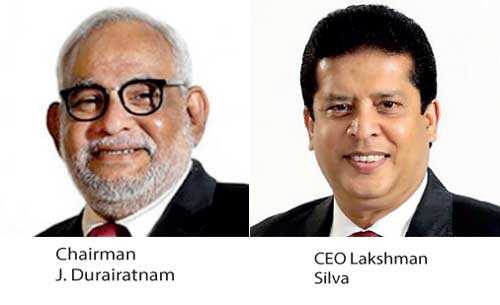Friday Nov 15, 2024
Friday Nov 15, 2024
Monday, 24 February 2020 01:29 - - {{hitsCtrl.values.hits}}
DFCC Bank said yesterday it was continuing with its growth strategy despite the turbulent macro situation which had resulted in dip in profit though top-line saw improvement.
DFCC Bank, the largest entity within the group recorded a Profit After Tax (PAT) of Rs. 2,828 million for the year ended 31 December 2019, excluding the fair value loss on Commercial Bank of Ceylon PLC (CBC) in comparison to PAT of Rs. 3,646 million recorded in the comparative year.
The bank’s PAT with the fair value loss on CBC shares amounted to Rs. 2,074 million for the current year against Rs. 2,768 million in the comparative year.
The Group recorded a PAT of Rs. 2,300 million for the year ended 31 December 2019 compared to Rs. 3,070 million in the comparative year. Decline in PAT is mainly due to the increase in impairment and taxes on financial services. Taxes on financial services increased to Rs. 1,548 million due to Debt Repayment Levy introduced during last quarter of 2018. 
NII and fee income
Notwithstanding the turbulent environment in the country, the bank recorded a Rs. 12,662 million in Net Interest Income (NII), which is a 2% growth year-on-year (YoY). This NII Growth was possible even after the bank meeting the conditions stipulated by Central Bank to reduce the lending rates by 250 basis points by December 2019 compared with the rates applicable in April 2019.
Net fees and commission income grew by 5% to Rs. 2,046 million as a result of the concentrated effort to increase non-funded business for the year ended 31 December 2019 from Rs. 1,944 million in the comparative year.
Operating expenses
As a part of its growth strategy, DFCC continuously invests in its organisation and infrastructure. The bank increased its island-wide footprint by commencing 20 full service branches in 30 Days. DFCC enhanced its delivery channels through core banking upgrades and the introduction of pioneering, digitally enabled products.
The bank also continued to invest in its brand and franchise, to enhance top of mind awareness and greater customer engagement for the bank with the objective of increasing a higher footfall. The outlay of these investments resulted an increase in operating expenses to Rs. 7,573 million from Rs. 6,604 million in the comparative year, which expects to generate positive results to the bank in the short to medium terms.
Impairment
The overall impairment provision increased due to adverse business environment faced by most industries. As a result, the impairment provision during the year under review increased to Rs. 1,669 million, compared to Rs. 1,056 million recorded in the comparable year. The bank’s NPL ratio as at 31 December 2019 increased to 4.85% compared to 3.28% recorded at the end of previous year. NPL in the banking industry also recorded an increasing trend from 3.4% in 2018 to 4.7% as at 31 December 2019.
Other comprehensive income
Investments in equity securities and Treasury bills and bonds (fixed income securities) are classified as financial assets and the change in fair value is recorded through other comprehensive income. Accordingly, fair value losses of Rs. 1,564 million and a net fair value gain of Rs. 2,126 million were recorded on account of equity and fixed income securities, respectively. The drop in the share price of Commercial Bank of Ceylon during the period mainly contributed to the reported fair value loss in equity securities, whilst the movement of interest rates of Treasury bills and bonds favourably resulted in the fair value gain that was recorded during the period.
Statement of financial position
The bank with a view to support accelerated economic growth in the country spearheaded by the Government and to address the issues faced by the stressed sectors, actively participated in offering concessionary credit and moratorium schemes to the clients as recommended by the Central Bank.
The bank’s CASA ratio, which represents the proportion of low-cost deposits stood at 22.72% by 31 December 2019. Part of the bank’s advance portfolio is funded through long-term concessionary credit lines enjoyed by the bank for a long period and when consider these concessionary term borrowings, the ratio is improved to 28.96% as at 31 December 2019.
DFCC Bank said it continues to aggressively pursue its role as a commercial bank by strengthening its core business, creating momentum in the industry with its constantly evolving best in class offerings and creating a culture of service amongst its people.
CEO Lakshman Silva said: “DFCC Bank, The Bank for Everyone, is well-positioned to serve the nation as a full-service commercial bank through a range of financial services that will promote wealth creation across the country.
“Going beyond traditional banking, we have embraced Digitalisation focusing on becoming the best customer centric and digitally enabled retail bank in 2025. While enabling best experiences for our customers by creating convenience through digital footprints, we have focused on making our employees also digitally empowered to support the initiative introduced by Central Bank in order to enhance the digitally driven culture.”
The Group comprises of DFCC Bank PLC (DFCC), and its subsidiaries – Lanka Industrial Estates Ltd. (LINDEL), DFCC Consulting Ltd. (DCPL), and Synapsys Ltd. (SL), the joint venture company – Acuity Partners Ltd. (APL); and the associate company – National Asset Management Limited (NAMAL).